Mysterious Prehistoric Statues In Bada Valley, Indonesia Surrounded With Countless Legends
A. Sutherland - AncientPages.com - There are hundreds of prehistoric megaliths and several impressive ancient stone statues located in the Bada Valley, Central Sulawesi just south of the Lore Lindu National Park, Indonesia.
They vary in shape and size and according to sources, the number of megalithic rocks is 1,451. No doubt, the megaliths represent a prehistoric heritage, older than Borobudur Temple, but no one knows exactly their purpose and use of these rocks in ancient times.
Two Dutch ladies standing by a statue in Bada Valley in the 1930s. Image credit: Tropenmuseum - CC BY-SA 3.0
Located in a distant, isolated village that only a small number of Indonesians have heard about, mysterious statues of Bada Valley, Indonesia have no inscriptions to explain what or who they actually symbolize, who their builders were, or why they were built.
The tallest and best-known carved standing stone statue in the valley is a statue known as 'Palindo' which translates as 'The Entertainer' and measures over 4 meters.
The "Entertainer" has round eyes and a large nose that extends down and a deeply carved mouth makes him Watu Palindo looking cheerful and friendly. Besides Watu Palindo, there is another famous stone - Langka Bulawa ("Queen with a golden leg"), which depicts a woman's figure.
There are 13 other finely carved statues in the Bada Valley, with others in the nearby Besoa and Napu valleys inside the Lore Lidu National Park.
Hundreds of megaliths in this region of the country that goes back to the 14th century are called watu ("stone") in the local Badaic language and arca ("statue") in Indonesian.
Some people suggest that the stones were carved around 5,000 years ago, while others say the megaliths were made about 1,000 years ago. Meanwhile, other people say that the stones are related to megalithic culture in Laos, Cambodia, and other regions in Indonesia in the past 2,000 years.
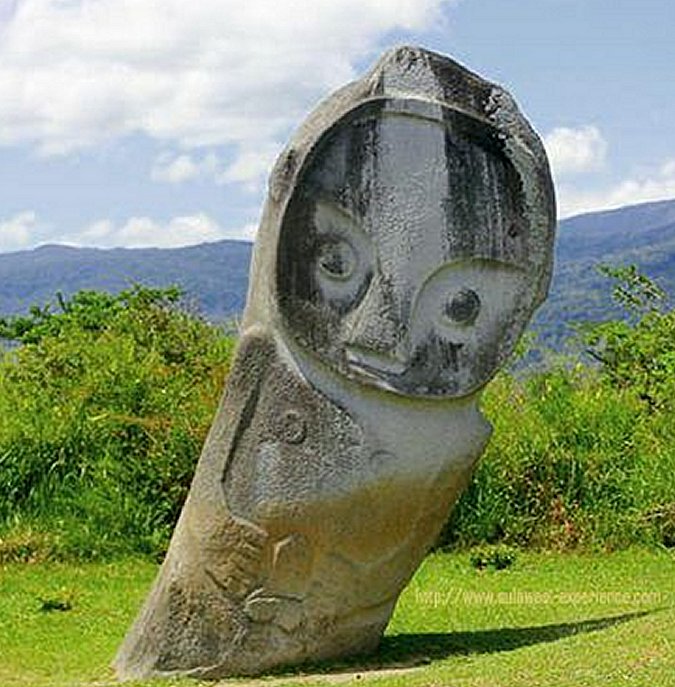
'Palindo' ('The Entertainer') measures over 4 meters. source
As we see, the dating of these impressive megaliths is uncertain, and for now, the bizarre statues are dated to be from 5000 to 1000 years old.
Archaeologists claim they haven’t found enough clues to explain their history yet, because at the time of their discovery, local people scraped the statues out of thick moss and dirt in order to clean them.
Other sources say, farmers grow rice around them and simply ignore them all, probably unaware of their historical value and mysteries behind them.
Many have long wondered who were these rock sculptors because it is commonly known that granite rocks are very hard, which makes working with them - very difficult.
Were The Megaliths Used To Worship Ancestors?
Local people Of Bada Valley and neighboring areas believe that the stone was used
to worship ancestors. They also have their own story about the origin of these very ancient megaliths.
Not only that, the residents also have stories about the origin of the formation
of these megaliths. According to local folklore, there was once a dangerous rapist who was finally condemned to be a piece of stone.
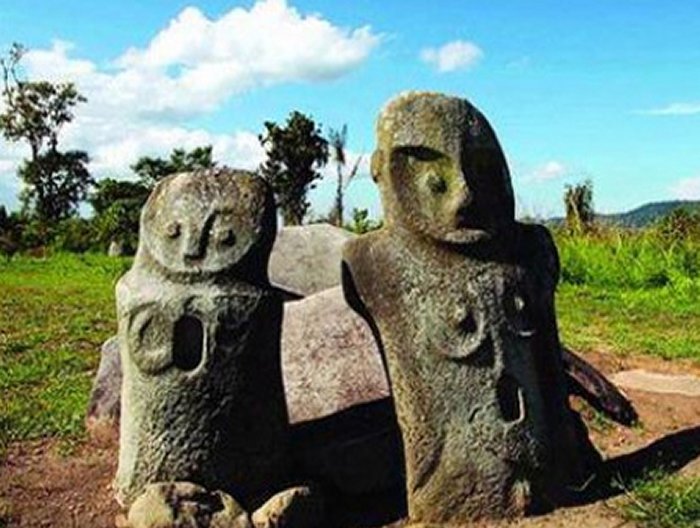
Bada Valley gigantic statues, Indonesia. source
Another story says about another large megalith named Tadulako. The community said that Tadulako was known as a village guard, but after stealing rice he was changed to stone.
Bada Valley's megaliths are also linked with human sacrifice or supernatural powers and some other ancient beliefs suggest they were intended to ward off evil spirits.
The elders in the village of Sepe believe that the statue of Palindo which means the entertainer in the local language is a representation of their predecessor population, the Tosaloge tribe. These people believe that the largest and the most celebrated statue in the area, which is that of Palindo ('The Entertainer') may represent Sepe's first mythological inhabitant, Tosaloge.
Yet another legend tells of the Raja of Luwu from the oldest kingdom in South Sulawesi, who once ordered 1800 statues to move from Sepe to Palopo. It was not an easy task for the workers because the distance between these two places is large.
Anyway, King Luwu wanted to prove his dominance over Bada, but his effort failed. One statue was ordered to originally face the south, but the Bada people turned it to face the west.
The Raja's followers tried to turn it back, but an accident happened and the statue fell onto its side, killing 200 people.
In the past, there was a tradition to give offerings to this statue before doing great work, such as opening new land for agriculture.
Written by – A. Sutherland - AncientPages.com Senior Staff Writer
Copyright © AncientPages.com All rights reserved. This material may not be published, broadcast, rewritten or redistributed in whole or part without the express written permission of AncientPages.com
Expand for referencesReferences:
Bellwood P. First Islanders: Prehistory and Human Migration in Island Southeast Asia
More From Ancient Pages
-
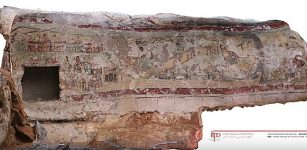 1,800-Year-Old Richly Painted Tomb Unearthed In Northern Jordan
Archaeology | Oct 1, 2018
1,800-Year-Old Richly Painted Tomb Unearthed In Northern Jordan
Archaeology | Oct 1, 2018 -
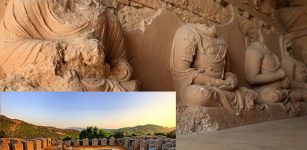 Takshashila: Renowned Learning Center That Attracted Buddhist Masters, Disciples And Students Of The World
Featured Stories | Sep 13, 2021
Takshashila: Renowned Learning Center That Attracted Buddhist Masters, Disciples And Students Of The World
Featured Stories | Sep 13, 2021 -
 Ancient Mysteries Of Japan – Strange Manuscripts Written In Unknown Language Discovered By Scientist – Part 1
Featured Stories | Aug 31, 2019
Ancient Mysteries Of Japan – Strange Manuscripts Written In Unknown Language Discovered By Scientist – Part 1
Featured Stories | Aug 31, 2019 -
 Lost Since 1362: Researchers Discover The Church Of Rungholt – A Sunken Medieval Trading Place
Archaeology | May 25, 2023
Lost Since 1362: Researchers Discover The Church Of Rungholt – A Sunken Medieval Trading Place
Archaeology | May 25, 2023 -
 26,000-Year-Old Footprints In Chauvet Cave: Oldest Evidence Of Human-Canine Relationship
Featured Stories | Dec 29, 2016
26,000-Year-Old Footprints In Chauvet Cave: Oldest Evidence Of Human-Canine Relationship
Featured Stories | Dec 29, 2016 -
 Ancient Tomb Belonging To Princess Of Ancient Nomads Discovered In China
Archaeology | Dec 20, 2015
Ancient Tomb Belonging To Princess Of Ancient Nomads Discovered In China
Archaeology | Dec 20, 2015 -
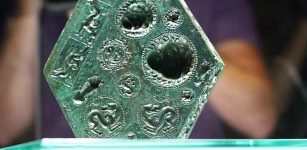 Unique 2,000-Year-Old Hexagonal-Shaped Bronze Matrix Of Sarmizegetusa Regia, Romania
Artifacts | Jan 7, 2016
Unique 2,000-Year-Old Hexagonal-Shaped Bronze Matrix Of Sarmizegetusa Regia, Romania
Artifacts | Jan 7, 2016 -
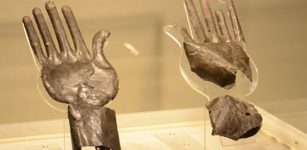 Mystery Of The Silver Hands Discovered In An Etruscan Tomb Full Of Secrets
Artifacts | Jun 12, 2015
Mystery Of The Silver Hands Discovered In An Etruscan Tomb Full Of Secrets
Artifacts | Jun 12, 2015 -
 Sirius Mystery – Scientific Evidence Of Alien Contact 5,000 Years Ago – Book Review
Civilizations | Apr 1, 2014
Sirius Mystery – Scientific Evidence Of Alien Contact 5,000 Years Ago – Book Review
Civilizations | Apr 1, 2014 -
 Jeanne de Clisson ‘Lioness Of Bretagne’: Her Black Painted Ships With Red Sails Terrorized English Channel
Featured Stories | Oct 4, 2019
Jeanne de Clisson ‘Lioness Of Bretagne’: Her Black Painted Ships With Red Sails Terrorized English Channel
Featured Stories | Oct 4, 2019 -
 Archaeological Discovery Of “Once-In-A-Lifetime” Medieval Gold Necklace In Britain
Archaeology | Dec 6, 2022
Archaeological Discovery Of “Once-In-A-Lifetime” Medieval Gold Necklace In Britain
Archaeology | Dec 6, 2022 -
 How Climate Change Contruibuted To The Transition From Nomadic Hunter-Gatherers To Settlement And Farming Societies
Archaeology | Nov 27, 2021
How Climate Change Contruibuted To The Transition From Nomadic Hunter-Gatherers To Settlement And Farming Societies
Archaeology | Nov 27, 2021 -
 On This Day In History: Battle Of Nineveh Was Fought – On Dec 12, 627 AD
News | Dec 12, 2016
On This Day In History: Battle Of Nineveh Was Fought – On Dec 12, 627 AD
News | Dec 12, 2016 -
 Full-Sized Model Of Noah’s Ark Created In The U.S. To Show People The Evolution Theory Is False
News | Oct 20, 2022
Full-Sized Model Of Noah’s Ark Created In The U.S. To Show People The Evolution Theory Is False
News | Oct 20, 2022 -
 Brahan Seer – A Legendary Scottish Nostradamus
Featured Stories | Feb 28, 2016
Brahan Seer – A Legendary Scottish Nostradamus
Featured Stories | Feb 28, 2016 -
 Lifestyle And Face Of 7th-Century Anglo-Saxon Teen – Reconstructed
Archaeology | Jun 20, 2023
Lifestyle And Face Of 7th-Century Anglo-Saxon Teen – Reconstructed
Archaeology | Jun 20, 2023 -
 8,000-Year-Old T-Shaped, Four-Sided Structure With Pyramidion – Uncovered in Turkey
Archaeology | Nov 23, 2019
8,000-Year-Old T-Shaped, Four-Sided Structure With Pyramidion – Uncovered in Turkey
Archaeology | Nov 23, 2019 -
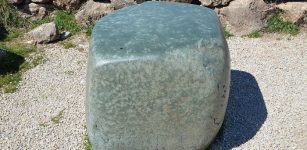 Mystery Of The Ancient Giant Wish Stone At Hattusa
Featured Stories | Oct 1, 2019
Mystery Of The Ancient Giant Wish Stone At Hattusa
Featured Stories | Oct 1, 2019 -
 On This Day In History: Captain James Cook Spotted The East Coast Of Australia – On Apr 19, 1770
News | Apr 19, 2017
On This Day In History: Captain James Cook Spotted The East Coast Of Australia – On Apr 19, 1770
News | Apr 19, 2017 -
 Preserve Elfdalian: Sweden’s Secret Forest Language From The Viking Era
Civilizations | May 21, 2015
Preserve Elfdalian: Sweden’s Secret Forest Language From The Viking Era
Civilizations | May 21, 2015

